| Author |
 Topic Topic  |
|
|
Kelly
Platinum Member
    
England
1571 Posts |
 Posted - 10 Mar 2010 : 10:30:21 AM Posted - 10 Mar 2010 : 10:30:21 AM





|
I'm sorry, this is long, but I'm really worried.
Iím having doubts about whether my farrier is the best one for Jack. I know nothing about hooves, and up until recently, didnít question what he did. However, last summer I asked the opinion of two friends. They use a different farrier, with a different method, but they use the same one as each other. Theirs trims very short, squares off the toe and does 4 point shoeing.
They think that mine leaves Jacks feet very long, and his heels very low, and that he has awful feet. Apparently, their farrier, and another one have also criticised the state of Jacks feet. No-one had told me this, until I asked!! Our chiropractor told me to ask my farrier to build his heels up as it is putting pressure on the back of his legs, being so low.
I donít feel that I know enough to tell a farrier, the expert, how to do his job. So I asked him to explain to me etc, and also got him to trim shorter, and take shoes a bit further back under his heel. And thought Iíd see how it goes.
However, this time, due to snow etc, Jack has gone nearly 10 weeks, and the foot he damaged a few years ago (at the coronet band) was very out of balance (one side grows faster than the other, which hadnít been apparent when he was being shod more frequently). I made a big deal of it to the farrier yesterday, and left him to it. I was in a rush yesterday, and didnít check it, but itís obvious this morning in daylight that itís still unbalanced. The outside is hitting the ground sooner than the inside. 
My quandry is, do I get my current farrier back to fix it, or cut my losses and get the same one as my friends? I like my current one, heís on time, good at communication if any problems, and good with Jack. I'd feel awful changing. But I have those doubts about whether heís doing the best job for Jack Ė or is he just doing the best he can with rubbish feet? I donít know enough to know.
Here are some pics that might help. Theyíre from last summer, but nothing much has changed. The first is the off hind, and the other three are off fore, NOT the damaged one. If anyone can make suggestions Iíd really appreciate it Ė this is obviously a crucial subject and Iím upset at the thought that maybe Iíve not been doing the best for Jack, and worried about what to do.




|
Kelly
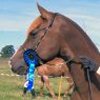  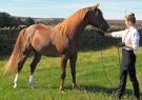   |
|
Report to moderator
|
|
|
BeckyBoodle
Gold Member
   

Australia
795 Posts |
 Posted - 10 Mar 2010 : 12:49:40 PM Posted - 10 Mar 2010 : 12:49:40 PM





|
I am definitely not an expert, but would sugest:-
- the bottom photo of the shoe. It looks like it doesn't go far enough back to support the heel, more so at the top of the photo than the bottom. However, the other photo looks like the hoof is missing a bit at the heel.
- the others of the front foot, do look a little long in the toe, which by implication makes them low at the heel. The head on one particular makes the foot look very tall, but it might be how you have taken it. However, if he hasn't been done for a while then there is likely to be a lot of growth to come off, even if the shoe hasn't worn much coz of not doing so much work with the bad weather.
I think the typical rule of thumb is that the hoof should follow the angle of the pastern and should be about 45%. Maybe get a set square or something and try and see what that would look like and then compare it to the angle of the hoof???
I think I would try to question, why the shoe doesn't go back, that his toes, for example, look a lot longer than your friend's horses and see what he says back.
I always hate situations like these, especially when you know you are not an expert on the subject, but the feet being in balance is so important to the horse as effects the rest of the skeleton.
Hope you get it sorted soon.
B
|
Report to Moderator  |
|
|
loosefur
Gold Member
   
584 Posts |
 Posted - 10 Mar 2010 : 3:23:48 PM Posted - 10 Mar 2010 : 3:23:48 PM





|
Well I'm a trimmer not a shoer but a few observations.
Photo one of the hind - the toe has been bull nosed i.e. the hoof has become convex at the front. Sometimes this is from the horse wearing the toe away, or sometimes a farrier or trimmer in an effort to shorten the toe incorrectly rasps the toe back too much, rather than shortening from underneath, making it bull nosed.
The second and third photos definitely look like the toe is way too long but rather than saying the heel is too low I would say the heel has been allowed to underrun - very common in shod horses. In the natural foot heels are very low - the hair line almost touching the ground - but the heel bulbs are chunky and wide at the back. Many shod feet have contracted heels as well as being under run. Under run and/or contracted heels indicate that the back of the foot is weak and that the horse will almost certainly be landing toe first rather than heel first.
The last photo it's hard to tell much as the shoe covers up the interesting parts of the underneath. His frogs look nice and healthy though, but ideally the front point of the frog should be about two/thirds the length of the hoof, whereas his are only about half the length, but again this is usually because of underrun heels and lack of stimulation as the shoe keeps the frog from contacting the ground.
Other things I notice are stress rings in his hoof wall, which indicate some dietary issues, usually too much sugar at certain points in the last nine months (either from hard feed or grass). Again these are very common so don't panic but perhaps have a think about what he's being fed and what his grazing is like. As a general rule of thumb hoof wall grows at 1cm a month, so if you measure up from a stress ring to the coronary band you can judge roughly when the stress ring was formed i.e. a stress ring 4cm down from the coronary band indicates some 'event' four months before.
As for four point shoeing/trimming(otherwise known as natural balance shoeing)I'm not a massive fan. The theory has some merit, bringing back the toe and therefore the break over, which is more natural, reducing the risk of tendon/ligament injuries. Wild horses have VERY short toes, which is where the idea comes from, however imposing a four point weight loading onto every hoof is not natural, different horses will load their hooves differently depending on their individual conformation and the terrian they are covering. Some will have three points, some two, some four, some more.
Without seeing your horse's damamged foot I can't really say as I'd have to see him moving but in general horses grow the foot they need, so when we balance a foot we do so in relation not to the foot in isolation but with regard to the whole horse. Some horses will land on one side of the foot first because that's what that leg's comformation requires to stay sound. However as your horse has a coronary band injury this may not be the case, so I wouldn't really want to comment on that specifically.
I'm not sure I've been much help because it's hard to give advice just from photos. Can you get another independent farrier out to see him? Not the one your friends use or has seen your horse before but someone else entirely - preferably one that comes recommended by someone else. You could ask on here if anyone in your area has a good farrier they can recommend. |
Report to Moderator  |
|
|
Kelly
Platinum Member
    
England
1571 Posts |
 Posted - 10 Mar 2010 : 4:53:09 PM Posted - 10 Mar 2010 : 4:53:09 PM





|
Thank you both VERY much!
That's just what I'm after - more info and how things SHOULD be.
Loosefur, your idea sounds very good - I'm in West Yorkshire, if anyone can recommend me an 'independent' farrier to come and have a look? (I hate even saying it, feel so disloyal...)
Re the 'bull-nosed' hind - he does drag his feet somewhat....
As for the rings on his foot, I will measure them.....it's unlikely to be too much sugar, as our grazing is not lush and he's on dengie hi-fi, speedibeet and supplements. Although, for a few months last summer he was on Spillers horse and pony nuts...
I have also read that the rings can be a sign of various stress - changes, injuries (not necessarily involving the foot), so I'll measure back and see if I can match them to anything. He manages to cause some sort of upset at various stages, usually by damaging himself in some way! This morning I arrived to a 3" scratch starting at the corner of one eye..... luckily very shallow. 
Can anyone recommend me any books?
Thank you again for taking the time to reply, this is just what I need.  |
Kelly
     |
Report to Moderator  |
|
|
phoenixbruka
Gold Member
   

England
1190 Posts |
 Posted - 10 Mar 2010 : 5:46:03 PM Posted - 10 Mar 2010 : 5:46:03 PM






|
Id recommend Paul Gordon, hes a remedial farrier who has clinic days at beaverhall and somerford park.
My boy had EXACTLY the same problems as yours and Paul has worked miricles. I'd recommend you also get xrays for the farrier to work correctly off instead of guessing and going soley on the hoof pastern axis. definately a road to disaster that one ( my boy is only just cming back into work after 5 months off!! ) )
susie |
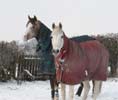 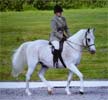 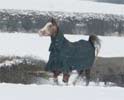 
www.liveryatcordwell.co.uk |
Report to Moderator  |
|
|
Slave 2 Magic
Gold Member
   
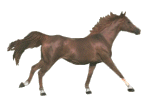
England
1023 Posts |
 Posted - 10 Mar 2010 : 5:57:30 PM Posted - 10 Mar 2010 : 5:57:30 PM





|
| Kelly, I am in West Yorkshire and the farrier I use now is very good. Magic's feet were too long and over the course of several shoeings he has totally altered the break over point and her feet are loads better. Where abouts are you? PM if you prefer. |
West Yorkshire
    |
Report to Moderator  |
|
|
loosefur
Gold Member
   
584 Posts |
 Posted - 10 Mar 2010 : 7:59:42 PM Posted - 10 Mar 2010 : 7:59:42 PM





|
Originally posted by KellyAs for the rings on his foot, I will measure them.....it's unlikely to be too much sugar, as our grazing is not lush and he's on dengie hi-fi, speedibeet and supplements. Although, for a few months last summer he was on Spillers horse and pony nuts... I have also read that the rings can be a sign of various stress - changes, injuries (not necessarily involving the foot), so I'll measure back and see if I can match them to anything. He manages to cause some sort of upset at various stages, usually by damaging himself in some way! This morning I arrived to a 3" scratch starting at the corner of one eye..... luckily very shallow.  Can anyone recommend me any books? Thank you again for taking the time to reply, this is just what I need. 
Kelly
You are right that rings in the hoof are a stress response. The actual process is the same - toxins attacking the lamellae that connect the hoof wall to the inner structures of the foot. These toxins are most commonly dietary related - the horse cannot digest sugar very efficiently and if there is too much sugar in the diet the hind gut acidifies, producing toxins (and can also cause gastric ulcers and colic). Severe attacks manifest themselves as what we call laminitis. Mild attacks cause stress rings, footiness in barefoot horses, intermitant lameness, pottery strides or just a reluctance to go forwards in shod horses (often misunderstood as the horse being lazy or naughty). Your horse's diet sounds pretty low sugar though Hi-Fi does have molasses in it and the Spillers nuts will have also contained molasses. Some horses are more sensitive to sugar than others (depends on their metabolism) and even a tiny amount of grass can be too much. But you're also right in that other things can cause stress rings - bascially anything that fails to be broken down properly by the body and produces the toxins... things like chemical wormers, vaccinations (these seem to form grooves in the hoof wall rather than ridges), anti-biotics, injuries.
I can recommend some books - but they're all barefoot related rather than about shoes. However you won't get better info about how the foot works than these books so should be essential reading for everyone whether they're interested in barefoot or not. Three books by Jaime Jackons - The Natural Horse, which is more about the whole horse but does go on to discuss feet and is massively educational; The Horse Owners Guide to Natural Hoofcare and Founder: Prevention and Cure the Natural Way. There's also a book by Pete Ramey called Making Natural Hoofcare Work for You. You can get all three from Amazon pretty cheap. |
Report to Moderator  |
|
|
Kelly
Platinum Member
    
England
1571 Posts |
 Posted - 10 Mar 2010 : 8:27:27 PM Posted - 10 Mar 2010 : 8:27:27 PM





|
Thanks again guys!
I texted my farrier to tell him about the unbalanced foot, and his response was not what I hoped for, to say the least. However, I haven't rung him yet to find out WHY he said what he did. I have another farrier coming tomorrow to have a look, recommended by a local livery yard who say they've seen loads and he's 'the best'.
Also have a lovely friend coming over tomorrow with some books, in return for pizza 
I will also take more photos tomorrow and post them.
I hope my farrier doesn't read this - I feel very disloyal  
Please keep your thoughts coming, the more I learn the better  |
Kelly
     |
Report to Moderator  |
|
|
ali bali
Gold Member
   
Scotland
641 Posts |
 Posted - 10 Mar 2010 : 8:49:01 PM Posted - 10 Mar 2010 : 8:49:01 PM





|
Hi Kelly, I don't know enough about feet to advise you either way, but I will say that you are paying your farrier hard earned cash to look after your horses feet, and if you are not happy with the way he is doing it I wouldn't feel guilty about changing who you use!
Good feet are vital as we all know, so is reliability. I am lucky enough to have a trained remedial farrier who spots and corrects minor problems as they arise before they cause any issues. He is also never more than 10 minutes late for any appointment (unless he has an emergency, in which case he cancels everything until he has done the best he can for the poorly horse, and quite right too!) He is worth his weight in gold (which seems to be what I pay him LOL)
Definitely go on recommendations, or keep your eyes down and when you see a really nice set of hooves ask who their farrier is  |
Report to Moderator  |
|
|
Theo
Silver Member
  

England
368 Posts |
 Posted - 11 Mar 2010 : 10:46:53 PM Posted - 11 Mar 2010 : 10:46:53 PM





|
Hi Kelly,
I agree with loosefur's observations, however IMHO, the 'bull noseing' on the hind feet do not look as if it's been caused by 'dumping of the toe' by the farrier, but moreso by the horse's natural horn growth.
In defence of your farier, he has done the right thing by shoeing wide at the heels and feathering the outer edges of the shoe so to encourage the heel to 'grow wide' to counter the contraction of the heels...
As for the off-fore, the hoof looks in balance, but the pastern does not... (laterally), he's putting more weight on the inside than the outside? So, naturally, Jack would grow his hoof more upright on the inside than the outside?
You must really ask him for the reasons behind his actions every step of the way... Do communicate!
How long have you had this farrier doing Jack's feet? IMHO something like this would probably take 24-36 months to rectify...? (And the first 12 months without shoes!)
There are 'quick fixes' by placing wedges on heels etc to alter the angles, but by raising the heel 'suddenly' at one shoeing, you are more likely to 'bow' the tendon and bringing about more headache in lameness!
On the subject of four point shoeing: One of my TB's would go cripplingly lame after 6 weeks from shoe binding, this is only suitable for some types of feet... As loosefur is quite correct to point out, without seeing where the hoof wall and white line are on the feet...(and also the going of the horse in motion) it's difficult to judge the suitability of such shoeing technique.I have seen great effect in improving the front feet break-over from the traditional 'roll-over' toes or even using quarter clipped (hind shoes) on the fronts to achieve the effect.
Is there any reason why those heels are breaking-up so drastically? Terrain, environment, nutrition? Do you do alot of trotting on road surfaces? (the reason I ask is that when a steel shoe strikes the ground, it resonates at a frequency of 800 hz like a tuning fork... which coincidentally is the frequency that will breakdown hoof material! ) )
IMHO, fix them heels and the rest will come right.
Time! Best of luck!
T  x x |
    |
Report to Moderator  |
|
|
garnet
Platinum Member
    

2382 Posts |
 Posted - 11 Mar 2010 : 10:56:13 PM Posted - 11 Mar 2010 : 10:56:13 PM





|
| If you don't feel confident about tackling your farrier (and I understand what you mean), can I suggest you speak to your vet about the problems you feel are being caused by the shoeing and get him to either discuss the problem/treatment with your current farrier or recommend/refer you to a remedial farrier. This would take the pressure off you and hopefully enable your horse to be properly shod. |
      |
Report to Moderator  |
|
|
Kelly
Platinum Member
    
England
1571 Posts |
 Posted - 12 Mar 2010 : 1:54:26 PM Posted - 12 Mar 2010 : 1:54:26 PM





|
Hi all
'Independent farrier' thinks that while it's not completely awful, the hinds being better than the fronts, it could be better.
'Anterior/posterior imbalance on all four, and severe medial/lateral imbalance on the damaged foot (near fore). However, off fore nicely balanced m/l. Toes a little too long and heels under run. Good strong feet. Easily rectifiable, wouldn't harm him to ride with foot like that, but wants sorting asap.'
He also thinks that the unlevel pastern/coronet band area could be sorted over time - I always assumed this was an unavoidable consequence of his injury.
I have books to read and a decision to make. Soon.
Here are more pics, taken yesterday, so 2 days after shoeing.

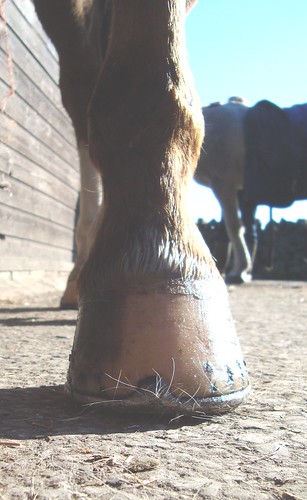


|
Kelly
     |
Report to Moderator  |
|
|
sasha
Gold Member
   

United Kingdom
518 Posts |
 Posted - 12 Mar 2010 : 3:37:21 PM Posted - 12 Mar 2010 : 3:37:21 PM





|
Is there any way you can go down the barefoot route. I havn't had a horse shod in 7 years now, and I can tell you that if you are patient and get a good trimmer, your horses heels will come back to where they should be naturally by lots of walking on tarmac. The heels will widen, the hoof will become more ' cone' shaped.. as it should be and the whole hoof will be a better shape and much stronger, as the walls will become thicker, the frog will be doing its job as a shock absorber too!! |
Report to Moderator  |
|
|
Kelly
Platinum Member
    
England
1571 Posts |
 Posted - 12 Mar 2010 : 4:10:52 PM Posted - 12 Mar 2010 : 4:10:52 PM





|
I wish I could go barefoot, but it's very stony round here. I tried it when Jack was first backed, but he winced with every step, and could only do a mile or so on roads before he felt footy.
I know it's a long process to get them there, but I don't feel I could do that to him.  |
Kelly
     |
Report to Moderator  |
|
|
loosefur
Gold Member
   
584 Posts |
 Posted - 12 Mar 2010 : 6:33:11 PM Posted - 12 Mar 2010 : 6:33:11 PM





|
It's very stony round me too and all mine are barefoot - one took a few months to transition, one a few weeks and one was sound on stones straight away. Whilst transitioning you just need some hoof boots so you can carry on working him - there's a wide range of hoof boots available now that are very easy to fit.
Generally if they remain 'ouchy' after a few months transitioning time it's because of their diet - cut out the sugar and you'll have a sound horse over the stoniest terrain. For those horses extra sensitive to sugar that can mean taking them off grass altogether and just feeding dried forage. Adding a magnesium supplement can also make the difference between having a horse footy on stones and having one totally sound as can changing all your hard feeds to ones without molasses  |
Report to Moderator  |
|
|
sasha
Gold Member
   

United Kingdom
518 Posts |
 Posted - 12 Mar 2010 : 9:09:49 PM Posted - 12 Mar 2010 : 9:09:49 PM





|
As loosefur has said, great boots available now.. renegades and the Easyboot Glove!
You also have some very good trimmers in Yorkshire who will fit boots to your horse and give you lots of support!!!
I also agree about sugar and grass...!!!! |
Report to Moderator  |
|
|
loosefur
Gold Member
   
584 Posts |
 Posted - 12 Mar 2010 : 9:32:10 PM Posted - 12 Mar 2010 : 9:32:10 PM





|
I've been so impressed by the changes in my horses since I took them barefoot (I could go on and on about the benefits  ) that I went out to the States at the end of last year to train as a barefoot trimmer with Jaime Jackson, so that I could help other people and horses get to where my lot are now. And I was someone who was VERY sceptical about the whole barefoot thing twelve months ago. ) that I went out to the States at the end of last year to train as a barefoot trimmer with Jaime Jackson, so that I could help other people and horses get to where my lot are now. And I was someone who was VERY sceptical about the whole barefoot thing twelve months ago. |
Report to Moderator  |
|
|
Kelly
Platinum Member
    
England
1571 Posts |
 Posted - 13 Mar 2010 : 11:02:39 PM Posted - 13 Mar 2010 : 11:02:39 PM





|
Hi agian guys
Thanks for your comments. I have to admit, I am interested in barefoot, so it might be worth finding out more. A couple of the books my friend has lent me are about barefoot, so I'll have a read.
As for the sugar in his diet, the Hi-fi is 'lite', but if anyone can recommend a chop with NO sugar, I'd get that (I haven't been able to find one). But I couldn't and wouldn't take him off grass entirely - he and his two friends live out all summer, and he'd go stir crazy without that!
|
Kelly
     |
Report to Moderator  |
|
|
Theo
Silver Member
  

England
368 Posts |
 Posted - 14 Mar 2010 : 10:04:17 AM Posted - 14 Mar 2010 : 10:04:17 AM





|
Hi Kelly,
Most brands of 'chop' are bound together with a certain amount of molasses so it wont go dusty, the other alternative is to use one bound by oil... I use Alfa-A Oil for mine.
I would also highly recommend feeding Seaweed and Rosehip blend of herbs for hoof strengthening.
T  x x |
    |
Report to Moderator  |
|
|
loosefur
Gold Member
   
584 Posts |
|
|
Theo
Silver Member
  

England
368 Posts |
 Posted - 14 Mar 2010 : 10:06:39 PM Posted - 14 Mar 2010 : 10:06:39 PM





|
Oh, oh, oh, oh...
Jo's just pointed out that Dengie does offer a product called 'Healthy Hooves'
Blog below...
Combining fibre sources that are all low in starch and sugars such as alfalfa, as well as a special low sugar coating Healthy Hooves is ideal to help maximise gut health and with a range of vitamins and minerals to complement those naturally occurring in alfalfa, Healthy Hooves will provide a balanced diet for your horse.
PROVEN NUTRIENT FOR HEALTHY HOOVES
Several studies have been conducted into how much biotin a horse requires. A study published in the Equine Vet Journal (1992), found that greater growth rates and hardness of hooves was achieved at a daily feeding rate of 15mg of biotin than at 7.5mg in horses diets. The level of biotin included in Dengie Healthy Hooves has been formulated accordingly and thus when fed at the recommended rates will provide your horse with 15mg of biotin per day.
Research published in the Vet Record (1987) demonstrated that alfalfa increases the quality and quantity of horn growth which was attributed to the highly available calcium and essential amino acids found naturally in alfalfa.
B-vitamins have a wide range of functions within the horses digestive system including energy metabolism and growth and development. Healthy Hooves was the first chopped fibre feed on the market with a full range of all these important nutrients.
KEY BENEFITS OF HEALTHY HOOVES
Dengie Healthy Hooves has a full range of B vitamins including biotin at levels that research has shown to be effective at maximising hoof health and was the first chopped fibre feed product on the UK market to include all these important nutrients.
Low energy. Horses and ponies that are overweight are at greater risk of laminitis. Healthy Hooves is very low in energy or calories at just 8.5MJ/Kg DE.
Low Sugar and Starch. Research has shown that horses and ponies predisposed to laminitis are at greater risk if fed cereals. Healthy Hooves is free from cereal grains.
Chelated Trace Minerals. These are important for improved bio-availability to the horse, i.e. they are more easily absorbed by the horses digestive system. Trace minerals are important for general condition including hooves and coat condition and are also integral components for the bodyís anti-oxidant system.
Essential High Fibre. Fibre provides slow release energy and is essential for maximising gut health.
Highly palatable. Healthy Hooves contains added garlic for great palatability and pellets for added interest.
Clever girlie she is!
T  x x |
    |
Report to Moderator  |
|
|
loosefur
Gold Member
   
584 Posts |
 Posted - 15 Mar 2010 : 10:56:54 AM Posted - 15 Mar 2010 : 10:56:54 AM





|
| What Dengie only put in the very small print on their bags of Healthy Hooves is that it does contain molasses - as does Happy Hoof and Safe and Sound. Not sure why they need to add molasses but they all do. Low levels yes but if you want to feed non-molassed fibre feeds then you need to look elsewhere. |
Report to Moderator  |
|
|
Karon
Gold Member
   
England
1411 Posts |
 Posted - 15 Mar 2010 : 1:40:31 PM Posted - 15 Mar 2010 : 1:40:31 PM





|
That last photo could be my Ash when she had shoes on - except Ash had even more difference in height of inside and outside of foot. Going barefoot - another one in a stony area too - really made a different to her and, apart from about 6 weeks at the start, I never need to use hoof boots with her. This was a horse who struggled to go over any stony ground at all with shoes on!
Doing a track system makes a big difference with my horses, it keeps them moving (and slimmer) and, as I have some hard standing at the top of my field, they also have something dry to stand on. |
Report to Moderator  |
|
|
Kelly
Platinum Member
    
England
1571 Posts |
 Posted - 15 Mar 2010 : 4:37:39 PM Posted - 15 Mar 2010 : 4:37:39 PM





|
Thank you all for your thoughts. I'm seriously considering barefoot, so will start reading these books. Haven't had chance yet due to cooking for 6 for Mothers Day yesterday, and taking little sis shopping on saturday!
Re diet - I will change to the Badminton Alfa-lite chop when the hi-fi lite is done (thank you Loosefur  ) Theo, he is on seaweed, micronised linseed and brewers yeast already (I've think I've read this combination referred to as Magic feet powder?!) ) Theo, he is on seaweed, micronised linseed and brewers yeast already (I've think I've read this combination referred to as Magic feet powder?!)
As for Paddock Paradise, I like the idea, but I share a field with 2 other horses - one fatty would definitely benefit, but the other needs all the grass he can get. Plus, I like Jack to have enough room to get out of the way when the other two pick on him, so the enclosed quarters wouldn't be great  . I may discuss options with the two ladies for this summer though. . I may discuss options with the two ladies for this summer though. |
Kelly
     |
Report to Moderator  |
|
|
Tricia
Bronze Member
 
Wales
161 Posts |
 Posted - 15 Mar 2010 : 6:33:32 PM Posted - 15 Mar 2010 : 6:33:32 PM





|
Hi Kelly,
Those photos you show are something that a good farrier could sort out quite easily. It would certainly be an easier route to go down than having to spend some months or longer transitioning to barefoot.
Tricia |
Report to Moderator  |
|
|
loosefur
Gold Member
   
584 Posts |
 Posted - 15 Mar 2010 : 10:20:59 PM Posted - 15 Mar 2010 : 10:20:59 PM





|
  Fortunately with hoof boots you can carry on working at the same level you were at when shod with no interruption. I took my gelding's shoes off mid-endurance season last year (June), didn't alter his work load one bit and was doing a 40 mile ride in mid-July. Got a Grade 2 to boot (pun intended!). Fortunately with hoof boots you can carry on working at the same level you were at when shod with no interruption. I took my gelding's shoes off mid-endurance season last year (June), didn't alter his work load one bit and was doing a 40 mile ride in mid-July. Got a Grade 2 to boot (pun intended!).
Kelly - if you have any questions about barefoot and/or hoof boots just ask  |
Report to Moderator  |
|
 Topic Topic  |
|
|
|

